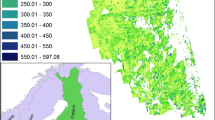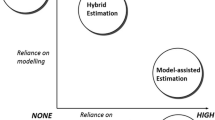Abstract
In efforts such as land use change monitoring, carbon budgeting, and forecasting ecological conditions and timber supply, there is increasing demand for regional and national data layers depicting forest cover. These data layers must permit small area estimates of forest area and, most importantly, provide associated error estimates. This paper presents a model-based approach for coupling mid-resolution satellite imagery with plot-based forest inventory data to produce estimates of probability of forest and associated error at the pixel-level. The proposed Bayesian hierarchical model provides access to each pixel’s posterior predictive distribution allowing for a highly flexible analysis of pixel and multi-pixel areas of interest. The paper presents a trial using multiple dates of Landsat imagery and USDA Forest Service Forest Inventory and Analysis plot data. The results describe the spatial dependence structure within the trial site, provide pixel and multi-pixel summaries of probability of forest land use, and explore discretization schemes of the posterior predictive distributions to forest and non-forest classes. Model prediction results of a holdout set analysis suggest the proposed model provides high classification accuracy, 88%, for the trial site.
Similar content being viewed by others
References
Banerjee S, Carlin BP and Gelfand AE (2004). Hierarchical modelling and analysis for spatial data. Chapman and Hall/CRC Press, Boca Raton
Banerjee S and Finley AO (2007). Bayesian multiresolution modeling of spatially replicated data. J Stat Plann Infer 137: 3193–3205
Banerjee S and Johnson GA (2006). Coregionalized single- and multi-resolution spatially-varying growth curve modelling with applications to weed growth. Biometrics 61: 617–625
Bechtold WA, Patterson PL (eds) (2005) The enhanced forest inventory and analysis program: national sampling design and estimation procedures. General Technical Report SRS–80. U.S. Department of Agriculture, Forest Service, Southern Research Station, Asheville, NC
Berger J, De Oliveira V and Sanso B (2001). Objective Bayesian analysis of spatially correlated data. J Am Stat Assoc 96: 1361–1374
Campbell JB (1996). Introduction to remote sensing, 2nd edn. Guilford Press, New York
Chilés JP and Delfiner P (1999). Geostatistics: modelling spatial uncertainty. John Wiley and Sons, New York
Cressie NAC (1993). Statistics for spatial data, 2nd edn. Wiley, New York
Ferguson TS (1996). A course in large sample theory. Chapman and Hall, London
Franco-Lopez H, Ek AR and Bauer ME (2001). Estimation and mapping of forest stand density, volume, and cover type using the k-nearest neighbors method. Remote Sens Environ 77: 251–1709
Gelman A, Carlin JB, Stern HS and Rubin DB (2004). Bayesian data analysis, 2nd edn. Chapman and Hall, London
Homer C, Huang C, Yang L, Wylie B and Coan M (2004). Development of a 2001 national landcover database for the United States. Photogramm Engi Remote Sens 70(7): 829–840
Kauth RJ, Thomas GS (1976) The tasseled cap—a graphic description of the spectral-temporal development of agricultural crops as seen by Landsat. Proceeding of the symposium on machine processing of remotely sensed data. Purdue University, West Lafayett, pp. 41–51
McRoberts RE, Wendt DG, Nelson MD and Hansen MH (2002). Using a land cover classification based on satellite imagery to improve the precision of forest inventory area estimates. Remote Sens Environ 81: 36–44
Spiegelhalter DJ, Best N, Carlin BP and Linde A (2002). Bayesian measures of model complexity and fit (with discussion). J Roy Statist Soc Ser B 64: 583–639
Tomppo E (1991). Satellite imagery-based national forest inventory of Finland. Inter Arch Photogramm Remote Sens 28: 419–424
Author information
Authors and Affiliations
Corresponding author
Rights and permissions
About this article
Cite this article
Finley, A.O., Banerjee, S. & McRoberts, R.E. A Bayesian approach to multi-source forest area estimation. Environ Ecol Stat 15, 241–258 (2008). https://doi.org/10.1007/s10651-007-0049-5
Received:
Revised:
Published:
Issue Date:
DOI: https://doi.org/10.1007/s10651-007-0049-5




